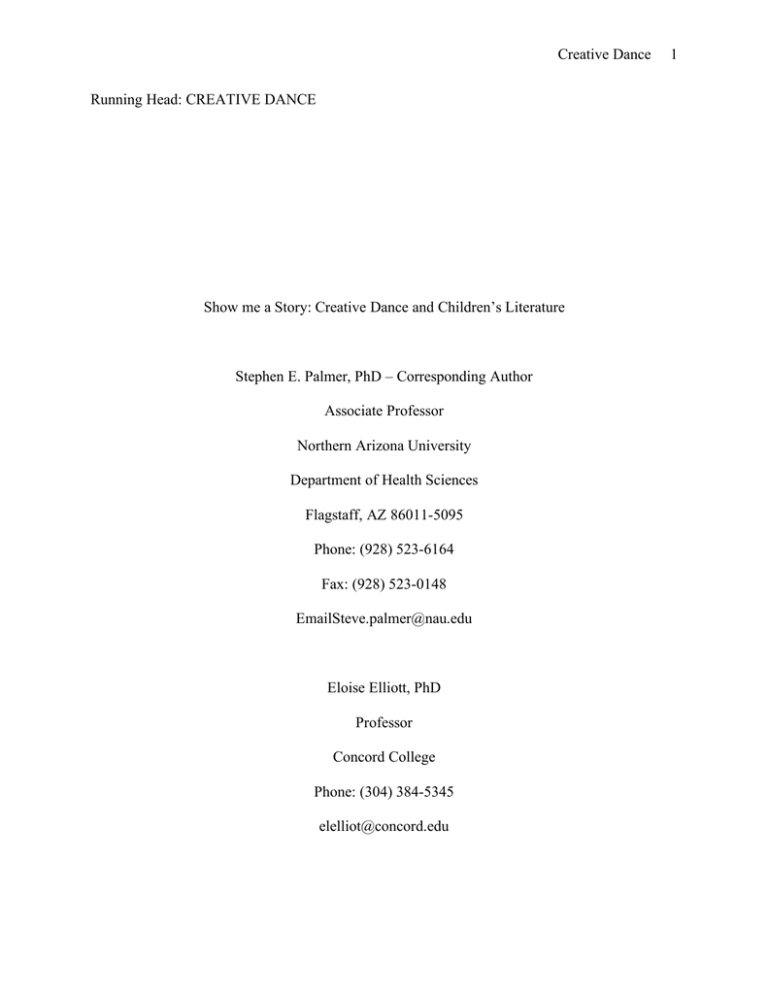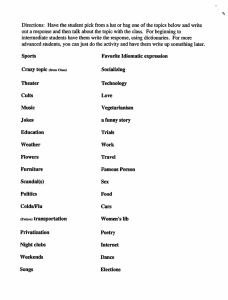Creative Dance 1 Running Head: CREATIVE DANCE
advertisement

Creative Dance Running Head: CREATIVE DANCE Show me a Story: Creative Dance and Children’s Literature Stephen E. Palmer, PhD – Corresponding Author Associate Professor Northern Arizona University Department of Health Sciences Flagstaff, AZ 86011-5095 Phone: (928) 523-6164 Fax: (928) 523-0148 EmailSteve.palmer@nau.edu Eloise Elliott, PhD Professor Concord College Phone: (304) 384-5345 elelliot@concord.edu 1 Creative Dance 2 Show me a Story: Creative Dance and Children’s Literature The National, and most state, Physical Education Standards suggest the importance of teaching dance in elementary school (NASPE, 2004). The most common approach to addressing these expectations, arguably, is through teaching folk, square, or line dances such as the Chicken Dance, Pata Pata, Virginia Reel, or Macarena. Although fun, such an approach typically does not emphasize a functional movement vocabulary, nor do they allow for creative expression. The focus of lessons typically is on execution of the dance, not necessarily improving quality of movement. The National Standards for Physical Education state “in the lower elementary grades, emphasis is placed on establishing a movement vocabulary and applying introductory concepts” (NASPE, 2004). Creative dance and rhythmic movement, an intimidating topic for many physical educators, provide a wonderful opportunity for children to learn and apply movement concepts. Creative dance is the expression of feelings, emotions, or stories through movement. Telling stories through movement is not a new concept, obviously, with many ideas available through Websites such as PE Central, and professional journals and text books. For example, Talena Cox’s Movement Plays have been specifically written using movement concepts terms in physical education (Cox, 1998). Many of the creative dances one might find include stories and poems created by physical educators. Another pool of creative dance material can be found through classic children’s literature. The purpose of this article is to share how popular children’s stories can be adapted to teach and reinforce movement concepts through creative dance. Going on a Bear Hunt (Oxenbury, 1989) and Honey, Honey…Lion (Brett, 2005) are presented in this article as examples of how movement concepts within the context of creative dance can be taught with children’s literature. We start, however, with a brief review of movement concepts. Creative Dance 3 Movement Concepts Where a locomotor, manipulative or non-manipulative skill would be considered a verb, movement concepts are adverbs describing the quality of movement (Graham, Holt/Hale, & Parker, 2004). Movement concepts fall within the following categories; space, effort, and relationships. Space includes directions (up/down, forward/backward, right/left, clockwise/counterclockwise), levels (low, middle, high), pathways (straight, curved, zigzag), and extensions (large/small, near/far). Effort includes force (strong/light), flow (bound/free), and time (fast/slow). Relationships can describe those with people (alone in mass, solo, partners, groups, between groups, unison/contrast, mirroring/matching, leading and following), objects and/or people (alongside, around, surrounding, meeting/parting, along/through, in front/behind, near/far, on/off, over/under), and of body parts (round, narrow/wide, twisted, symmetrical/nonsymmetrical) (Graham et al., 2004). Movement concepts can describe how one performs a specific motor skill. For example, a child might throw a ball at a high or low level, with light or strong force, and over or under a net. When traveling, a child can skip slowly while demonstrating free flow in a curvy pathway alongside a partner while mirroring the partner’s movements (For a thorough description of movement concepts, consult “Children Moving” by Graham, Holt/Hale & Parker, 2004). Children knowing and applying movement concepts helps establish a functional movement vocabulary. It is important when teaching children in physical education that on command they can perform bound and free flowing jumps, travel in straight, curvy or zigzag pathways when skipping, or strike a ball with a racket with strong or light force. Graham, HoltHale & Parker (2004) equate movement concepts in physical education to knowing the colors in art, the alphabet in language arts, and numbers in math. Once this vocabulary is established, we Creative Dance 4 can guide children to explore different qualities of movement regardless of the skill theme taught. These concepts can then be applied as movement becomes more complex as applied in sport and lifetime activities. Children’s literature commonly includes many phrases and terms that correspond with movement concepts. For example, stories that describe animals lend themselves to children displaying movements representative of particular animals. Elephants might move with strong force, bound flow, and in straight pathways. Rabbits might move in fast time, zig zag pathways, and bouncing to get body parts into a high level. Children’s stories also frequently have repeating patterns and rhythms that children can remember, which helps elicit particular movement patterns and sequences. With some thought, many children’s stories can be used to teach and reinforce movement concepts in physical education. Physical educators can translate children’s stories to movement by defining characters and acts in the story, followed by practicing those movements, culminating with putting the entire story together in a creative dance. Following are steps to take to adapt children’s stories to movement. We’re Going on a Bear Hunt (Oxenbury, 1989) and Honey, Honey… Lion (Brett, 2005) are used to illustrate how movement concepts can be taught, practiced and reinforced in creative dance. Preparation The first step is for the physical educator to select and read the story that will lend itself to “acting out” parts of the story. Once you are familiar with the story, identify either scenes or acts by which children will act out the story. Most books easily break down into acts. For example, every two pages in Bear Hunt provide a new environment through which the characters travel. These include grass, a river, mud, a forest, snowstorm, and a cave. Honey, Honey… Lion Creative Dance 5 has three main acts, beginning with a Badger’s betrayal of a Honeyguide (bird), followed by the Honeyguide leading the Badger to the Lion, ending with flight from the Lion. After identifying some of the potential movement concepts for different parts of the story, decide how you will organize your class to act out the story. For example, in Bear Hunt, the characters travel in a group throughout the text, suggesting that having children travel in groups during class would be appropriate. In contrast, Honey, Honey… Lion requires children to act in groups of three, with one child leading and the other following until they disturb an angry lion, which then chases the fleeing badger while the bird follows them both. Next, you’ll want to make copies of pages of the book to help prompt children as they work. Many copy machines can enlarge images which are useful for creating charts to post on the wall, or handouts for children to reference while developing their creative dance. The fourth step is to select equipment that might be used as props by children as they perform. Using Bear Hunt as an example, a course with tarps representing water and mud, cones representing trees, or a cave made out of mats will make the activity more fun for children. With Honey, Honey… Lion, jump ropes can represent tree roots, a balance beam a fallen log, a tarp water, and various stacked pads or apparatus to jump off of can represent a termite mound. Your students might also have some creative alternatives. Introducing the Dance/Story Organization is necessary to consider prior to presenting children with the task, however, the children themselves should help define and describe movements of each character and act in the story. This can help reinforce the movement vocabulary. Begin by reading the story to the children. If possible, recruit the classroom teacher to first introduce stories to the children. Creative Dance 6 While you’re reading the story, prompt the children to identify emotions, animals, concepts, or movements that can be translated to movement concepts. These movements can then be acted out by all children. For example, in Bear Hunt, as characters travel through long, wavy grass, students could perform free flowing movements and could practice following/leading in curvy pathways. While stumbling and tripping through the forest, movement might be described as zig zagged, bound flow, and ducking under trees or hopping over stumps (levels). In Honey, Honey… Lion, the bird’s emotions of excitement to anger can be performed, as could the Badger as it goes from excitement, to content, to ever growing frustration, to fright. Read through each section of the story, followed by children defining how the characters and emotions can be represented through movement concepts. Children then immediately act out those particular movements, followed by reading the next section of the book and repeating the process until the entire book has been covered. It is critical that the teacher guide children to use movement concepts such as force, pathways, levels, time, and/or relationships. Dress Rehearsal The next step within the physical education class is to group children if necessary, assign or have them select parts, then go through each act of the creative dance. In Bear Hunt, have small groups move together in mass around the gym, or through the obstacle course representing each of the environments in the story. With Honey, Honey… Lion, have each group of three children identify who is the bird, the badger, and the Lion. Go through each section of the book and have children act those parts out using and identifying movement concepts that represent the animals and emotions. Go through the entire story at least one time for children to practice their parts. You will need to read the story to the children out loud as they act out each part. Creative Dance 7 The Performance Finally, put the entire dance together by reading the story out loud while children perform their respective parts. Children may also read or recite the story while moving, particularly those children who are more skillful, which would allow a teacher to move about and offer feedback. Other ideas include dimming and bringing lights up, using a speaker system, projecting the pages of the story on a large screen or wall, or having the story pre-recorded with accompanied music to make the experience more dramatic. Invite parents, teachers, administrators or other classes to watch the performance. The books presented here as examples represent only two of a multitude of stories that can be translated to creative dance by children and teachers. Classics such as Where the Wild Things Are (Sendak, 1963) and The Very Quiet Cricket (Carle, 1990) are just two more children’s stories you can use in physical education. Start with classroom teachers. Ask what stories are covered in class and begin to adapt those to physical education. There is no end to the possibilities. Young children love to move and express themselves. It’s unfortunate that a stigma frequently exists related to teaching “dance”, which causes many of us to avoid teaching this important content. Taking an interdisciplinary approach and using existing children’s stories to teach, practice, and apply movement concepts through creative dance can provide a fun and wonderful opportunity for children to gain and/or improve their functional movement vocabulary. Creative Dance References Brett, J. (2005). Honey, Honey...Lion. New York, NY: G.P. Putnam's Sons. Carle, E. (1990). The Very Quiet Cricket. New York: Philomel Books. Cox, T. (1998). Movement Plays. Blacksburg, VA: PE Central. Graham, G., Holt/Hale, S., & Parker, M. (2004). Children Moving: A Reflective Approach to Teaching Physical Education (Sixth ed.). Mountain View, CA: Mayfield. NASPE. (2004). Moving into the future: National standards for physical education (2nd ed.). Reston, VA: McGraw-Hill. Oxenbury, H. (1989). We're Going on a Bear Hunt. New York: Simon & Schuster. Sendak, M. (1963). Where the Wild Things Are. New York: Harper Collins. 8



